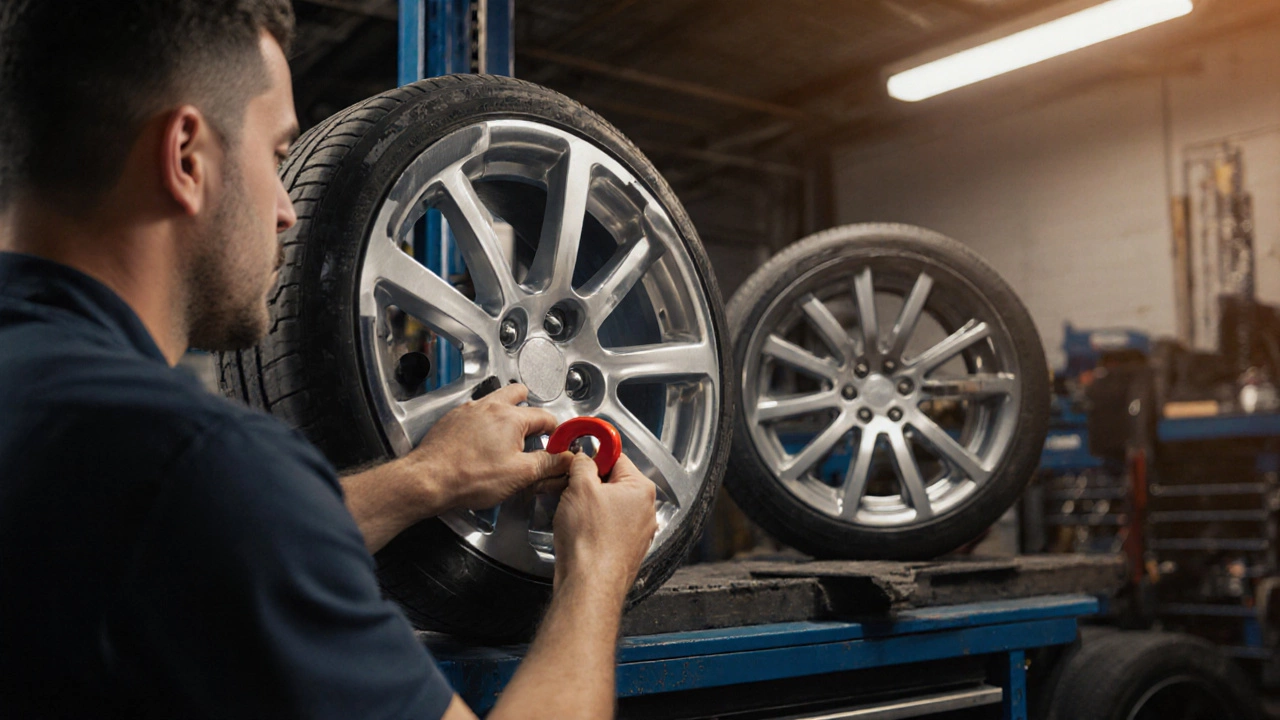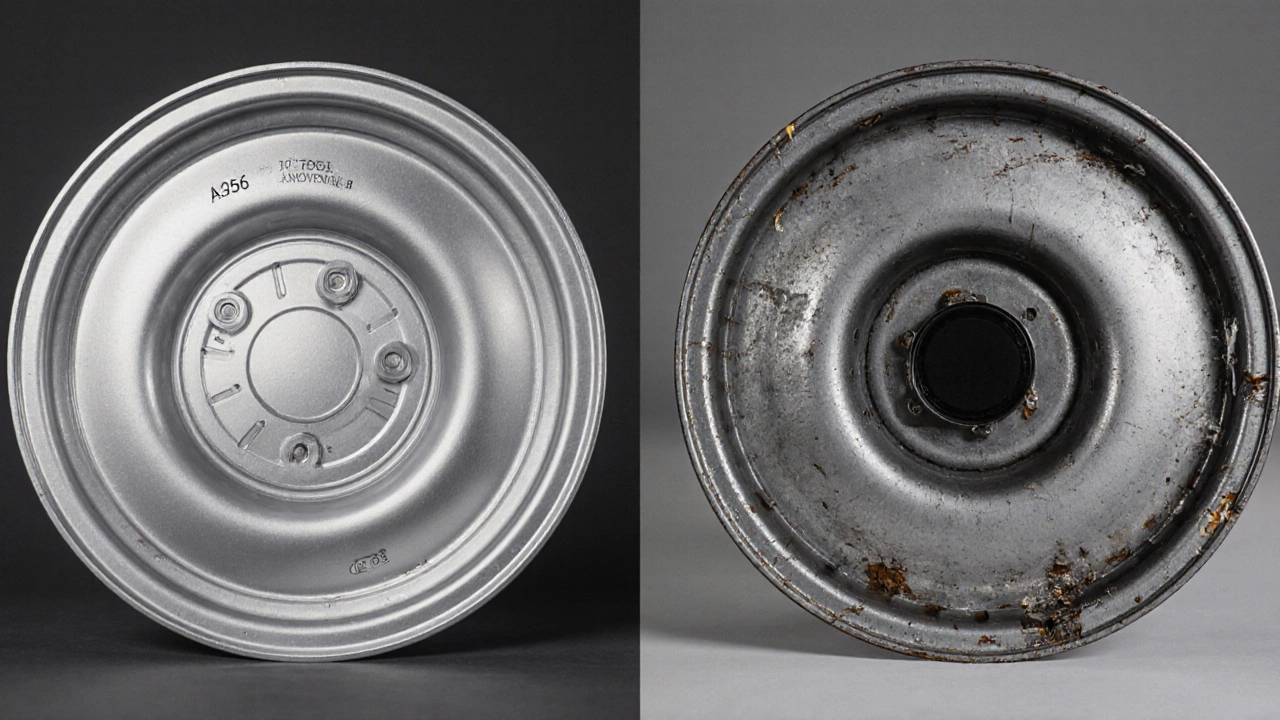Alloy Wheel Identification Tool
Is Your Wheel Alloy or Steel?
Use this diagnostic tool to determine if your car wheels are alloy or steel. Follow the steps below to get an accurate assessment.
Your Wheels Are Likely:
Ever looked at your car’s wheels and wondered if they’re really alloy-or just painted steel? You’re not alone. Many people think shiny, lightweight wheels mean alloy, but that’s not always true. Steel wheels can be painted to look just as flashy. The difference matters: alloy wheels affect ride quality, fuel efficiency, and resale value. So how do you actually know what’s under the shine?
Check the weight
Alloy wheels are significantly lighter than steel ones. A typical 17-inch steel wheel weighs around 20 to 25 pounds. An alloy wheel of the same size? Usually 14 to 18 pounds. That’s a noticeable difference. If you’ve ever swapped a wheel off your car, you probably felt it. Steel feels dense, clunky. Alloy feels like it could almost float. Try lifting one wheel at a time-compare the heft. If it feels surprisingly light for its size, it’s likely alloy.Look for a casting mark
Alloy wheels are made by pouring molten metal into a mold. That leaves behind subtle clues. Look closely at the back of the wheel, near the center hub or inside the spokes. You’ll often see small, raised letters or numbers like “A356” or “ADC12.” These are alloy designations-A356 is a common aluminum-silicon mix used in car wheels. Steel wheels don’t have these codes. They’re stamped or pressed, so you’ll see sharp, clean edges without any casting seams or rough textures.Test the magnet
This is the easiest trick. Grab a fridge magnet. Hold it against the outer face of the wheel. If it sticks firmly, you’re looking at steel. If it doesn’t stick at all-or barely clings-you’ve got alloy. Aluminum and magnesium alloys aren’t magnetic. Steel is. This test works even if the wheel is covered in dirt, paint, or brake dust. Just wipe off the surface a bit and try again. If the magnet holds on tight, it’s steel. No grip? You’ve got alloy.Inspect the finish and surface texture
Alloy wheels are usually polished, machined, or coated with a clear lacquer to show off the metal’s natural look. You’ll often see fine, circular machining marks around the spokes or rim edge. These are from the lathe that shaped the wheel after casting. Steel wheels, even if painted, usually have a smoother, uniform surface. No grooves, no tool marks. If you see tiny lines radiating from the center like a fingerprint, that’s a sign of alloy. Also, alloys tend to show scratches more easily. A small scrape on a steel wheel might just chip paint. On an alloy, you’ll see the raw metal underneath-silver or gray, not black.
Check the manufacturer’s specs
Your car’s owner’s manual or build sheet (sometimes found under the spare tire or in the glovebox) will list wheel specs. Look for terms like “alloy,” “lightweight,” or “cast aluminum.” If it just says “steel” or “standard,” you’re not dealing with alloy. You can also search your car’s VIN online using free tools like the National Highway Traffic Safety Administration’s VIN decoder. It will list factory wheel type. If you bought the wheels aftermarket, check the packaging or the brand’s website. Companies like BBS, OZ, or Enkei always label their products clearly.Listen to the sound
This one’s subtle, but it works. Tap the wheel gently with a wrench or your knuckle. Steel wheels make a dull, thud-like sound. Alloy wheels ring out with a higher-pitched, metallic “ping.” It’s similar to tapping a glass versus a plastic container. The difference comes from how the material vibrates. Aluminum transmits sound faster and with less dampening. If you’ve got both wheels off the car, tap each one side by side. The difference is obvious.Compare with known examples
If you know someone with a similar car model, ask to compare wheels. For example, a base-model 2024 Toyota Corolla comes with steel wheels and plastic center caps. The LE or XSE trims get alloy wheels with a more intricate design. Look at photos online of your exact model and trim level. Sites like Edmunds or Car and Driver show factory specs with photos. If your wheels match the higher trim’s appearance, they’re likely alloy. If they look flat, plain, and lack detail, they’re probably steel.
What if you’re still unsure?
Take it to a local tire shop. Most places have a handheld X-ray fluorescence (XRF) analyzer-they use it to test metal composition for recycling. It’s quick, free, and accurate. Just ask them to scan one wheel. They’ll tell you within seconds if it’s aluminum alloy, steel, or something else. Or, if you’re handy, buy a cheap metal tester kit online. They cost under $30 and give you a rough reading of metal type using electrical conductivity.Why does it matter?
Knowing your wheel type isn’t just about bragging rights. Alloy wheels improve handling because they’re lighter-less unsprung weight means better grip and responsiveness. They also help with fuel economy. A set of four alloy wheels can improve your MPG by 1-3%, depending on size and design. They dissipate heat better too, which helps your brakes last longer. And if you’re selling your car, alloy wheels add value. Buyers notice them. Steel wheels? Not so much.Common mistakes to avoid
Don’t assume all shiny wheels are alloy. Some steel wheels have chrome plating or high-gloss paint that looks identical from a distance. Don’t rely on brand names alone. Just because a wheel says “Sport” or “Racing” doesn’t mean it’s alloy. Always verify. And never use acid-based cleaners on alloy wheels-they eat away at the protective coating and cause pitting. Use pH-neutral wheel cleaners instead.Can I paint steel wheels to look like alloy?
Yes, you can paint steel wheels with high-gloss metallic paint to mimic alloy, but it won’t change the weight or performance. The magnet test will still reveal steel underneath. Paint can chip, fade, or peel over time, especially near the rim edge where brake dust builds up. Real alloy wheels maintain their finish longer and don’t require repainting.
Are all aftermarket wheels alloy?
No. Many aftermarket wheels are still made from steel, especially budget models sold at discount auto parts stores. Always check the product description for terms like “cast aluminum,” “forged magnesium,” or “alloy.” If it just says “steel” or doesn’t specify, assume it’s steel. Reputable brands like Rays, HRE, or Konig always list material type.
Do alloy wheels rust?
Alloy wheels don’t rust like steel, but they can corrode. Aluminum oxidizes into a white, powdery substance, especially if the clear coat is damaged or if road salt gets trapped under the wheel lip. This is more common in coastal areas or places with harsh winters. Regular cleaning and waxing prevent corrosion. Steel wheels, on the other hand, rust from the inside out-especially around the bolt holes or bead seat.
Can I tell if a wheel is forged or cast alloy?
Forged alloys are stronger and lighter than cast ones. They usually have a more refined, intricate design and a smoother, almost polished finish. Cast alloys often look more basic, with thicker spokes and visible casting lines. Forged wheels are also significantly more expensive-usually over $500 per wheel. If your wheels cost under $200 each, they’re almost certainly cast.
Is it safe to drive with damaged alloy wheels?
Small scratches or scuffs are fine, but deep cracks, bends, or holes compromise structural integrity. Alloy wheels don’t flex like steel-they crack. If you hit a pothole hard and the wheel looks warped or has visible cracks, don’t drive on it. Even a small crack can grow under stress and cause a blowout. Get it inspected by a professional. Steel wheels can sometimes be repaired by welding, but alloy wheels usually need replacement.
If you’ve confirmed your wheels are alloy, treat them right. Clean them monthly with a soft brush and a pH-neutral cleaner. Avoid pressure washers directly on the wheel face-they can force water behind the lip and cause corrosion. Keep them waxed every few months to protect the finish. And if you’re ever in doubt, trust the magnet test. It’s simple, reliable, and doesn’t cost a cent.